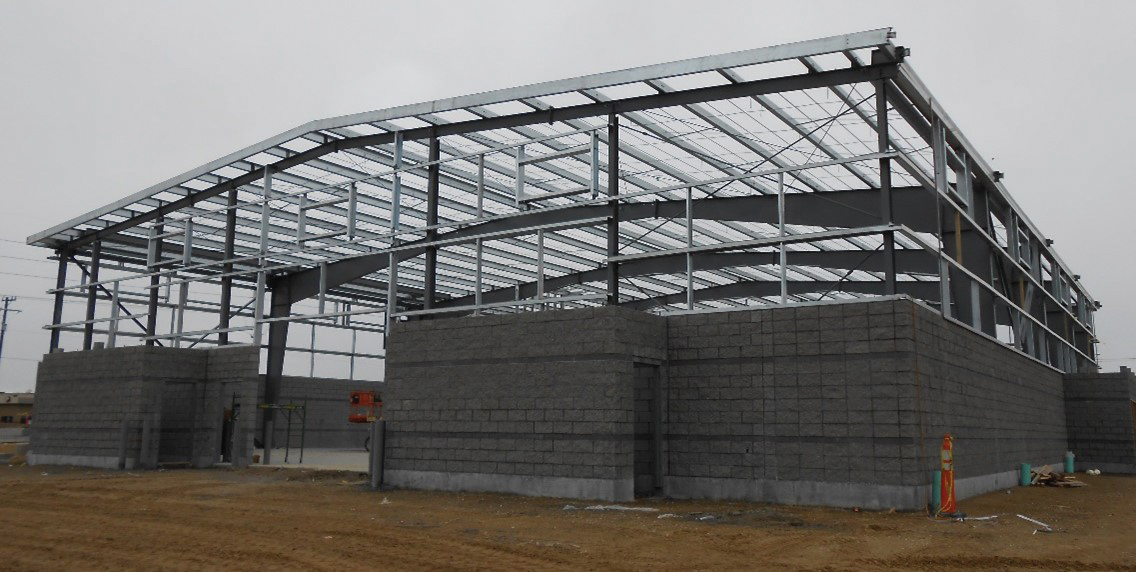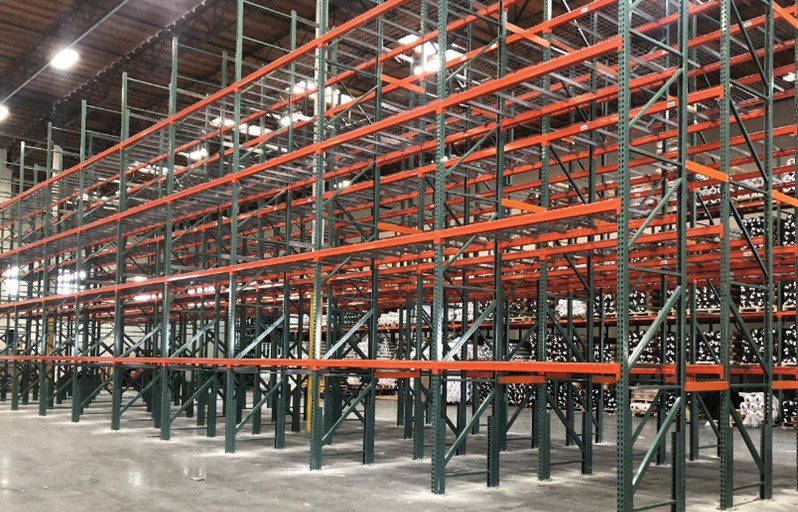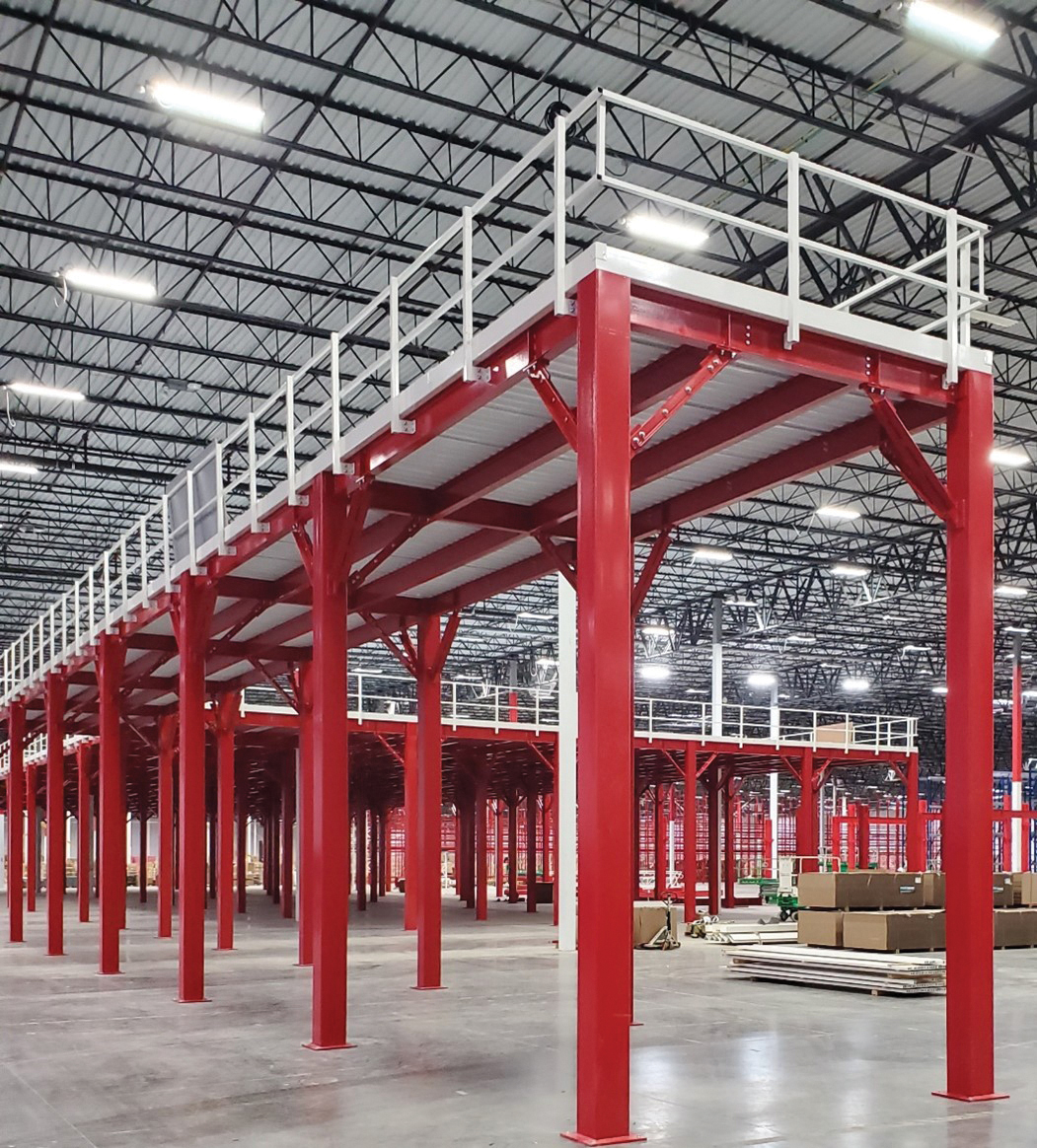This article provides an overview of the reorganization of Chapter 22 on steel in the 2024 International Building Code (IBC) and a discussion of new sections for metal building systems, industrial boltless steel shelving, industrial steel work platforms; and stairs, ladders, and guarding serving steel storage racks and industrial steel work platforms. Only a portion of the chapter’s total number of code changes is discussed in this article.
Reorganization of Chapter 22
IBC Chapter 22 covers requirements for the quality, design, fabrication, and construction of steel structures, including structural steel, cold-formed steel, steel bar joists, steel cable structures, and steel storage racks. Changes to the 2024 IBC include an editorial reorganization of Chapter 22 for better flow, usability, and clarification of steel provisions in the building code (see the summary table). New provisions for structural stainless steel, cold-formed profiled steel diaphragm panels, steel decks, industrial boltless steel shelving, steel work platforms, and metal building systems have also been added, along with applicable reference standards. References to several existing steel standards, including ANSI/AISC 360-22 Specification for Structural Steel Buildings, are also updated in the 2024 IBC. Not all editorial and renumbering changes are shown here.
SECTION 2201
GENERAL
2201.1 Scope. The provisions of this chapter govern the quality, design, fabrication and erection of steel construction.
2201.2 Identification. Identification of steel members shall be in accordance with the applicable referenced standards within this chapter. Other steel furnished for structural load-carrying purposes shall be identified for conformity to the ordered grade in accordance with the specified ASTM standard or other specification and the provisions of this chapter. Where the steel grade is not readily identifiable from marking and test records, the steel shall be tested to verify conformity to such standards.
2201.3 Protection. The protection of steel members shall be in accordance with the applicable reference standards within this chapter.
2201.4 Connections. The design and installation of steel connections shall be in accordance with the applicable reference standards within this chapter. For special inspection of welding or installation of high-strength bolts, see Section 1705.2.
2201.5 Anchor Rods. Anchor rods shall be set in accordance with the approved construction documents. The protrusion of the threaded ends through the connected material shall fully engage the threads of the nuts, but shall not be greater than the length of the threaded portion of the bolts.
SECTION 2205 2202
STRUCTURAL STEEL AND COMPOSITE STRUCTURAL STEEL AND CONCRETE
2205.1 2202.1 General. The design, fabrication and erection of structural steel elements and composite structural steel and concrete elements in buildings, structures and portions thereof shall be in accordance with AISC 360.
(Reference to several steel standards, including ANSI/AISC 360-22, ANSI/AISC 341-22 and ANSI/AISC 358-22, are also updated in the 2024 IBC as reflected in IBC Chapter 35. The remainder of IBC Section 2202 includes editorial and renumbering changes and is not shown for brevity.)
SECTION 2203
STRUCTURAL STAINLESS STEEL
2203.1 General. The design, manufacture and erection of austenitic and duplex structural stainless steel shall be in accordance with AISC 370.
Section 2210 2204
COLD-FORMED STEEL
2210.1 2204.1 General. The design of cold-formed carbon and low-alloy steel structural members not covered in Sections 2206 through 2209 shall be in accordance with AISI S100. The design of cold-formed stainless-steel structural members shall be in accordance with ASCE 8. Cold-formed steel light-frame construction shall comply with Section 2211. The design of cold-formed steel diaphragms shall be in accordance with additional provisions of AISI S310 as applicable. Where required, the seismic design of cold-formed steel structures shall be in accordance with the additional provisions of Section 2210.2 2204.2.
2210.2 2204.2 Seismic design requirements for cold-formed steel structures. The design and detailing of cold-formed steel seismic force-resisting systems shall be in accordance with Section 2204.2.1 and 2204.2.2 as applicable. Where a response modification coefficient, R, in accordance with ASCE 7, Table 12.2-1, is used for the design of cold-formed steel structures, the structures shall be designed and detailed in accordance with the requirements of AISI S100, ASCE 8, or, for cold-formed steel special-bolted moment frames, AISI S400.
2204.2.1 CFS special bolted moment frames. Where a response modification coefficient, R, in accordance with ASCE 7, Table 12.2-1, is used for the design of cold-formed steel special bolted moment frames, the structures shall be designed and detailed in accordance with the requirements of AISI S400.
2204.2.2 Cold-formed steel seismic force-resisting systems. The response modification coefficient, R, designated in ASCE 7, Table 12.2-1 for “Steel systems not specifically detailed for seismic resistance, excluding cantilever column systems” shall be permitted for systems designed and detailed in accordance with AISI S100. Such systems need not be designed and detailed in accordance with AISI S400.
SECTION 2205
COLD-FORMED STAINLESS STEEL
2205.1 General. The design of cold-formed stainless steel structural members shall be in accordance with ASCE 8.
SECTION 2211 2206
COLD-FORMED STEEL LIGHT-FRAME CONSTRUCTION
2206.3 Cutting and notching. The cutting and notching of holes in cold-formed steel framing members shall be in accordance with AISI S240 for structural members and AISI S220 for nonstructural members.
(Additional changes to this section were renumbering only and are not shown for brevity.)
SECTION 2208
STEEL DECK
2210.1.1 2208.1 Steel decks. The design and construction of cold-formed steel floor and roof decks and composite slabs of concrete and steel deck shall be in accordance with this section SDI SD. The design of cold-formed steel diaphragms shall be in accordance with additional provisions of AISI S310, as applicable.
(Previous Sections 2210.1.1.1 through 2210.1.1.3 have been deleted without substitution.)
CHAPTER 35
REFERENCED STANDARDS
American Institute of Steel Construction (AISC)
ANSI/AISC 341-22 16 Seismic Provisions for Structural Steel
ANSI/AISC 358-22 18 Prequalified Connections for Special and Intermediate Steel Moment Frames for Seismic Applications
ANSI/AISC 360-22 16 Specification for Structural Steel Buildings
ANSI/AISC 370-21 Specification for Structural Stainless Steel Buildings
American Iron and Steel Institute (AISI)
AISI S310-20 w/S1-22 North American Standard for the Design of Profiled Steel Diaphragm Panels, 2020 Edition, with Supplement 1, 2022 Edition
Steel Deck Institute (SDI)
SDI SD-2022 Standard for Steel Deck
SDI NC—2017 Standard for Noncomposite Steel Floor Deck
SDI RD—2017 Standard for Steel Roof Deck
SDI-C—2017 Standard for Composite Steel Floor Deck—Slabs
Change Significance: Based on the extensive reformatting of IBC Chapter 22, Table 1 provides a summary of revised section numbers and content. This article will provide additional discussion of new provisions added to IBC Sections 2210, 2211, 2212, and 2213.
IBC Section 2203 introduces a new section on structural stainless steel with reference to the new ANSI/AISC 370, Specification for Structural Stainless Steel Buildings. This standard provides a uniform practice for the design of structural stainless steel-framed buildings and other structures.
IBC Section 2208 references the new SDI steel deck (SD) standard. The three previous SDI steel deck standards (RD, NC, and C) were combined into a single standard that covers both roof and floor deck applications. This change removes the previously referenced SDI RD (Steel Roof Deck), NC (Non-Composite Steel Floor), and C (Composite Steel Floor) standards and substitutes the new combined steel deck standard.
IBC Sections 2204 and 2208 on cold-formed steel members and decks include a new reference to AISI S310 with newly developed Supplement 1. This standard, first published in 2013, includes design provisions for diaphragms consisting of profiled steel decks or panels, which include fluted profiles and cellular deck profiles. The diaphragm may be installed with or without insulation between the panels and supports and may be supported by materials made of steel, wood, or concrete. Supplement 1 clarifies the design requirements for diaphragms filled with structural concrete used in the construction of floors. It also provides direction in calculating the resistance of perimeter attachment fasteners, including headed studs, welds, screws, and proprietary fasteners.
Cold-formed stainless-steel provisions are placed in IBC Section 2205 with reference to existing standard ASCE 8 Specification for the Design of Cold-Formed Stainless Steel Structural Members. The ASCE 8-20 standard was previously referenced in the 2021 IBC Section 2210 on cold-formed steel.
Metal Building Systems (IBC 2210)
New IBC Section 2210 includes provisions and an accompanying new definition to clarify design requirements for metal building systems.

CHAPTER 2
DEFINITIONS
METAL BUILDING SYSTEM. An integrated set of fabricated components and assemblies that form a complete or partial building shell that is designed by the manufacturer. This system typically includes but is not limited to primary framing composed of built-up structural steel members, secondary members that are cold-formed steel or open-web steel joists, a metal panel roof system and exterior wall cladding. The system is manufactured in a manner that permits plant or field inspection prior to assembly or erection.
SECTION 2210
METAL BUILDING SYSTEMS
2210.1 General. The design, fabrication and erection of a metal building system shall be in accordance with the additional provisions of this section.
2210.1.1 Design. The design of metal building systems shall be in accordance with Sections 2210.1.1.1 through 2210.1.1.4, as applicable.
2210.1.1.1 Structural steel. The design, fabrication and erection of structural steel shall be in accordance with Section 2202.
2210.1.1.2 Cold-formed steel. The design of cold-formed carbon and low-alloy steel structural members shall be in accordance with Section 2204.
2210.1.1.3 Steel joists. The design of steel joists shall be in accordance with Section 2207.
2210.1.1.4 Steel cable. The design, fabrication and erection of steel cables, including related connections, shall be in accordance with Section 2214.
2210.2 Seismic design. Where required, the seismic design, fabrication and erection of the structural steel seismic force-resisting system shall be in accordance with Section 2202.2.1 or 2202.2.2, as applicable.
Change Significance: Metal building systems are significantly different from other forms of steel construction, especially regarding the shared design responsibilities between the metal building system manufacturer and registered design professional for the project. Metal building systems often contain assemblies made of a variety of components, such as structural steel, cold-formed steel, and steel cables. These systems are typically highly optimized structures that are heavily dependent on bracing components to function as designed. Some bracing components consist of materials that are not considered to be “structural steel.” This addition to IBC Chapter 22 and the accompanying new definition clarifies the design requirements for metal building systems.
Many construction documents still use the nonexistent Metal Building Manufacturers Association standards as the governing design requirements. Adding specific referenced standards for the components of a metal building leads to accurate construction documents and improved construction practices.
By clarifying the design requirements for different metal building system parts, the special inspection requirements are improved. New IBC Section 1705.2.6 provides special inspection provisions for these systems (see STRUCTURE December 2023 for more information).
Industrial Boltless Steel Shelving (IBC 2211)
New IBC Section 2211 references standard ANSI/MH 28.2, which applies to industrial boltless steel shelving.
SECTION 2211
INDUSTRIAL BOLTLESS STEEL SHELVING
2211.1 General. The design, testing and utilization of industrial boltless steel shelving shall be in accordance with MHI ANSI/MH 28.2. Where required by ASCE 7, the seismic design of industrial boltless steel shelving shall be in accordance with Chapter 15 of ASCE 7.
CHAPTER 35
REFERENCED STANDARDS
Material Handling Institute (MHI)
ANSI/MH 28.2-2022 Design, Testing and Utilization of Industrial Boltless Steel Shelving
Change Significance: New IBC Section 2211 references standard ANSI/MH 28.2, developed by the Storage Manufacturers Association (SMA) of the Material Handling Institute (MHI) for the design, testing, and utilization of industrial boltless steel shelving with assistance from the Federal Emergency Management Agency (FEMA) Seismic Code Support Committee. This standard applies to boltless shelving placed on mobile carriages; multi-level boltless shelving systems, such as pick modules, catwalks, and deck-overs; and boltless shelving used in conjunction with an automated storage and retrieval system.

The structural framing components for these systems are made of cold-formed or hot-rolled steel structural members. ANSI/MH 28.2 does not apply to industrial steel pallet racks (addressed by ANSI/MH 16.1), industrial cantilever racks (addressed by ANSI/MH 16.3), boltless shelving structures not fabricated from steel, industrial steel bin shelving, or shelving systems built with slotted metal angles. Boltless shelving is typically a prefabricated, free-standing, non-building structure that utilizes a designed framing system. It is generally located within an industrial or warehouse environment that does not allow access by the general public. Personnel working within the confines of spaces with boltless shelving structures are presumed to be properly trained, physically able, and appropriately attired for the intended working environment.
ANSI/MH 28.2 applies to boltless shelving structures installed within a building and potentially subjected to seismic loads. Loads from other environmental exposures, such as snow, wind, or rain loads, are not addressed in this standard. ANSI/MH 28.2 does not cover any design requirements that need to be addressed for supported equipment that would subject a shelving system to significant dynamic loading or harmonic vibration that has the potential to cause structural damage or metal fatigue. For applications beyond the scope of ANSI/MH 28.2 evaluation by a qualified design professional is required.
Industrial Steel Work Platforms (IBC 2212)
New IBC Section 2212 references standard ANSI/MH 28.3, which applies to industrial steel work platforms.
SECTION 2212
INDUSTRIAL STEEL WORK PLATFORMS
2212.1 General. The design, testing and utilization of industrial steel work platforms shall be in accordance with MHI ANSI/MH 28.3. Where required by ASCE 7, the seismic design of industrial steel work platforms shall be in accordance with Chapter 15 of ASCE 7.
CHAPTER 35
REFERENCED STANDARDS
Material Handling Institute (MHI)
ANSI/MH 28.3-22 Design, Testing and Utilization of Industrial Steel Work Platforms
Change Significance: New IBC Section 2212 references standard ANSI/MH 28.3, developed by the SMA for the design, testing, and utilization of industrial steel work platforms with assistance from the FEMA Seismic Code Support Committee.
An industrial steel work platform is typically a prefabricated free-standing non-building structure with an elevated surface that utilizes a pre-designed framing system and is located within an industrial or similarly restricted environment. Flooring may include other structural or non-structural elements such as concrete, steel, and engineered wood products.

ANSI/MH 28.3 does not apply to platforms whose structural framing components are not made from steel. This standard is based on the work platform being restricted from general public use, and those working on the work platform are properly trained, appropriately dressed, and physically able to work on such platforms in an industrial or warehouse environment.
ANSI/MH 28.3 applies to work platforms potentially subjected to seismic loads. Loads from other environmental exposures, such as snow, wind, or rain loads, are not addressed in this standard. For applications beyond the scope of ANSI/MH 28.3, evaluation by a qualified design professional is required.
Stairs, Ladders and Guarding for Steel Storage Racks and Industrial Steel Work Platforms (IBC 2213)
New IBC Section 2213 references standard ANSI/MH 32.1, which applies to fixed stairways and ladders along with guards for elevated platforms used in material handling structures.
SECTION 2213
STAIRS, LADDERS AND GUARDING FOR STEEL STORAGE RACKS AND INDUSTRIAL STEEL WORK PLATFORMS
2213.1 General. The design and installation of stairs, ladders and guarding serving steel storage racks and industrial steel work platforms shall be in accordance with MHI ANSI/MH 32.1.
CHAPTER 35
REFERENCED STANDARDS
Material Handling Institute (MHI)
ANSI/MH 32.1-2018 Stairs, Ladders and Open-Edge Guards for Use with Material Handling Structures
Change Significance: The Rack Manufacturers Institute (RMI) and SMA, two product groups of MHI, have compared and compiled Occupational Safety and Health Administration (OSHA) and building code provisions that apply to employee access ways serving various material handling structures. This information has been incorporated into the newly referenced standard ANSI/MH 32.1. This standard applies to fixed stairways and ladders along with guards for elevated platforms used in material handling structures. The stairways and ladders are attached to structures such as racking pick modules, shelving pick modules, decked-over platforms, and free-standing work platforms. Newly referenced standard ANSI/MH 28.3 applies to the design, testing, and utilization of industrial steel work platforms (see Section 2212 in this article for background).
Not all stairs, ladders and guards for steel-framed platforms and work areas are governed by ANSI/MH 32.1. Application is limited to a very specialized subset of stairs, ladders, and guards for “industrial steel work platforms used in material handling structures” within its scope. For example, consider a steel-framed platform used to service HVAC equipment in a factory. The guards on the HVAC access platform have to comply with IBC Section 1607.9, which covers loads on handrails and guards. The stairs or ladder used to access the HVAC platform also have to comply with the structural and architectural requirements in the IBC, not ANSI/MH 32.1. Extending the stair, ladder, and guard provisions of ANSI/MH 32.1 standard to all “industrial steel work platforms” is not appropriate.
Conclusion
Structural engineers should be aware of significant structural changes in the 2024 IBC Chapter 22 for steel. Changes include an editorial reorganization of the chapter for better flow, usability, and clarification of steel provisions in the building code. New provisions for structural stainless steel, cold-formed profiled steel diaphragm panels, steel decks, industrial boltless steel shelving, steel work platforms, and metal building systems have also been added along with applicable reference standards. Reference to several existing steel standards, including ANSI/AISC 360-22 for structural steel, are updated. New IBC Section 2210 includes provisions and an accompanying definition to clarify design requirements for metal building systems. New IBC Section 2211 references standard ANSI/MH 28.2, which applies to industrial boltless steel shelving. New IBC Section 2212 references standard ANSI/MH 28.3, which applies to industrial steel work platforms. Finally, the new IBC Section 2213 references standard ANSI/MH 32.1, which applies to fixed stairways and ladders along with guards for elevated platforms used in material handling structures. ■
